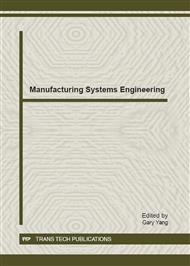[1]
G.J. Foschini and M.J. Gans, On limits of wireless communications in a fading environment when using multiple antennas, Wireless Personal Commun., vol. 6, no. 3, pp.311-335, Mar. (1998).
DOI: 10.1023/a:1008889222784
Google Scholar
[2]
Yangyang Zhang, Chunlin Ji, W. Malik, D. O'Brien, and D. Edwards, Receive Antenna Selection for MIMO Systems over Correlated Fading Channels, IEEE Trans. Wireless Commun. vol. 8, pp.4393-4399, Sept. (2009).
DOI: 10.1109/twc.2009.071404
Google Scholar
[3]
L. Dai, S. Sfar and K.B. Letaief, Receive antenna selection for MIMO systems in correlated channels, IEEE Conf. Commun., vol. 5, pp.2944-2948, June (2004).
DOI: 10.1109/icc.2004.1313069
Google Scholar
[4]
E. Telatar, Capacity of multi-antenna Gaussian channels, Eur. Trans. Telecom., vol. 10, pp.585-595, Nov. (1999).
DOI: 10.1002/ett.4460100604
Google Scholar
[5]
J.S. Park and D.J. Park, A new antenna selection algorithm with low complexity for MIMO wireless systems, IEEE Conf. Commun., vol. 4, pp.2308-2312, May (2005).
DOI: 10.1109/icc.2005.1494747
Google Scholar
[6]
A.F. Molisch, M.Z. Win, Y.S. Choi, and J.H. Winters, Capacity of MIMO systems with antenna selection, IEEE Trans. Wireless Commun., vol. 4, pp.1759-1772, July (2005).
DOI: 10.1109/twc.2005.850307
Google Scholar
[7]
R.W. Heath, S. Sandhu, and A. Paulraj, Antenna selection for spatial multiplexing systems with linear receivers, IEEE Commun. Lett., vol. 5, pp.142-144, April (2001).
DOI: 10.1109/4234.917094
Google Scholar
[8]
D.A. Gore, R.W. Heath, and A.J. Paulraj, Transmit selection in spatial multiplexing systems, IEEE Commun. Lett., vol. 6, pp.491-493, Nov. (2002).
DOI: 10.1109/lcomm.2002.805517
Google Scholar
[9]
A. Gorokhov, "Antenna selection algorithms for MEA transmission systems[C]. IEEE Conf. Acoustics, Speech, and Signal Processing, vol. 3, pp.2857-2860, May (2002).
DOI: 10.1109/icassp.2002.1005282
Google Scholar
[10]
A. Gorokhov, D.A. Gore, and A.J. Paulraj, Receive Antenna Selection for MIMO Spatial Multiplexing: Theory and Algorithms,. IEEE Trans. Signal Processing, vol. 51, pp.2796-2807, Nov. (2003).
DOI: 10.1109/tsp.2003.818204
Google Scholar
[11]
A. Gorokhov, D.A. Gore, and A.J. Paulraj, Receive antenna selection for MIMO flat fading channels: Theory and algorithms, IEEE Trans. Inf. Theory, vol. 49, p.2687–2696, Oct. (2003).
DOI: 10.1109/tit.2003.817458
Google Scholar
[12]
D.S. Shiu G.J. Foschini M.J. Gans, and J.M. Kahn, Fading correlation and its effect on the capacity of multi-element antenna systems, IEEE Trans. Commun., vol. 48, pp.502-513, (2000).
DOI: 10.1109/26.837052
Google Scholar
[13]
H. Kim, H. Kim, N. Kim, H. Park, S. Seo, and J. Choi, Efficient transmit antenna selection for correlated MIMO channels, IEEE Conf. Wireless Commun. and Networking, pp.1-5, April (2009).
DOI: 10.1109/wcnc.2009.4917704
Google Scholar
[14]
L. Dai, S. Sfar, and K.B. Letaief, Optimal Antenna Selection Based on Capacity Maximization for MIMO Systems in Correlated Channels, IEEE, Trans. Commun., vol. 54, pp.563-573, March (2006).
DOI: 10.1109/tcomm.2006.869778
Google Scholar
[15]
D.S. Shiu, G.J. Foschini, M.J. Gans, and J.M. Kahn, Fading correlation and its effect on the capacity of multi-element antenna systems, IEEE Conf. Universal Personal Commun. vol. 1, pp.429-433, Oct. (1998).
DOI: 10.1109/icupc.1998.733015
Google Scholar


